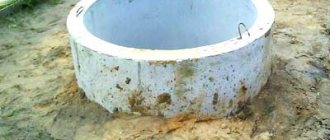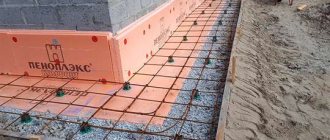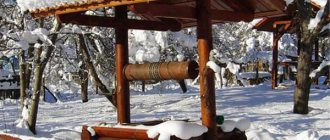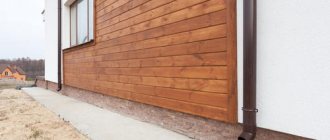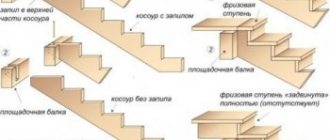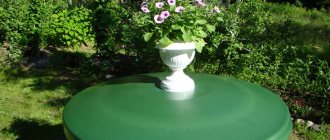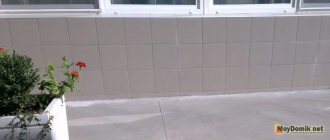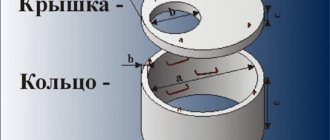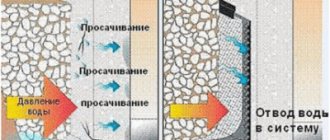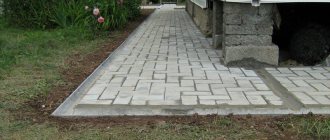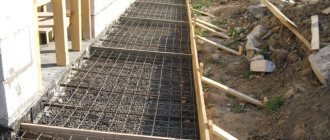backfilling
The name is taken by analogy with anti-heaving sand filling pockets around foundations. Around wells it is recommended to do it in a similar way, but using a waterproofing film. This backfill is usually called a soft blind area. Its width must be at least 1.2 m.
To build a soft blind area, the fertile layer around the well is removed, waterproofing is laid and sand is poured over it. It is first recommended to fill the gap between the soil and the well trunk, which is formed during the work process, with sand. Through it, water can penetrate to the base of the well and from there into the well itself. And if the barrel is leaking, a more direct path is possible - through the gaps between the rings.
But this option clearly did not suit me. The fact is that a soft blind area only works if there is no water in the sand. Otherwise, the sand will freeze with the rings and act on them like any other heaving soil—squeezing them to the surface. After the craftsmen finished the work, the water in my well was almost level with the surface of the earth.
It was also not possible to arrange drainage to take it to a depth of one and a half meters.
Clay replacement
Today, many companies offer materials that can replace clay. Such materials include a mixture of sand and gravel or ordinary sand. But can all this become a substitute for clay?
Sand, as a material, is not designed to retain water. Sand is a filter for water, that is, this material simply allows it to pass through. After the sand allows water to pass through, it comes into contact with the concrete rings and penetrates into the well shaft through possible cracks.
Although clay can get wet, it is a completely waterproof material. Due to the fact that clay can get wet, during severe frosts in winter you may see a slight displacement or advancement of the well rings.
Although today manufacturers offer us various materials, clay is indispensable. It will not allow the soil layer to be moistened.
Clay well area
To drain surface water from the well, it is also recommended to make a blind area. In its simplest form, it can be built from clay. Taking into account the possibility of heaving, its thickness should be 10-50 cm. It is not worth making the blind area thicker, since in this case it approaches the design of a clay castle, and problems associated with it arise.
A significant disadvantage of a clay blind area is the need to organize a protective coating over it. The fact is that the clay itself, when wet, turns into “mud”, which is unpleasant to walk on. This increases the labor intensity and cost of building such a blind area.
Despite this, I still decided to make a clay blind area around my well. And to reduce heaving forces, additionally insulate the soil around the well.
The soil on our site is clayey. The fertile layer goes to a depth of 40-50 cm, and clay begins below. So I decided to select a layer of soil around the well at a distance of about a meter and fill the pit with clay. Luckily there was enough of it - next to the well there was a pile of clay taken out by the workers when digging the well. The quality of the clay suited me quite well. And there was an opportunity to partially recycle it.
When the soil layer and what the workers called the “lock” were removed, a fairly wide gap opened between the soil and the rings. It became clear that the urgent recommendation for those who are going to make a castle or other protective structures around the well is to begin this work in 1-3 years, when the soil around the rings is compacted. The Internet is replete with photographs of failed blind areas around wells, which is the result of their premature construction.
But it was not my plan to wait that long. I decided to speed up the process of silting up the gap somewhat by trying to fill it with clay. This had to be done in several stages. I placed the clay all the way to the top in the slot and compacted it. But the next day it was discovered that water had filled the pit, and the clay had settled down, and the gap opened again.
To continue the work, I pumped water out of the well (about two rings), as a result it also left the crack. And again and again I put clay in it to the top and compacted it, the water filled the pit, and the clay settled. I did this several times. At some point, the clay stopped settling - the gap remained filled for several days.
For reliability, I decided to add liquid glass to the top layer of clay filling the gap. Having made holes in it with a shovel handle about a meter deep, poured liquid glass into them and tamped the clay with it again.
After this, he began filling the pit around the well with clay. I did this in small layers, compacting them and forming a slight slope away from the well.
Well insulation
My upper ring rises 75 cm above the ground. Accordingly, only 15 cm of this ring is underground. In my opinion, this is too little so that even when frozen with the ground, forces sufficient to lift this ring and tear it off from the second ring from above could arise. The next seam is located at a depth of just over a meter. The second ring is more susceptible to the forces of frost heaving than others, and it was necessary to reduce this impact. The only way available to me to do this was to insulate the blind area.
Not reaching the surface by about 15 cm, I laid insulation on the clay. I had pieces of expanded polystyrene (EPS) on hand - parts of the refrigerator packaging that I had stored for a long time for such an occasion - and polyethylene foam (EPS). I cut the insulation into sectors and laid it, trying to cover the joints. I laid a plastic film on top of the slab and covered it with soil with a slight slope from the well.
It must be said that the freezing of the soil around the well is somewhat less than around the foundation of the house. This occurs due to the flow of heat from the well - the water in it usually does not freeze. To enhance this effect, I also insulated the ring above the ground level - I wrapped the ring in PPE and laid it on top of a light frame made of wooden slats.
The measures taken gave the desired result. The well survived the first winter without destruction of the upper seams, despite the fact that the snow cover last winter was small and the frosts were significant.
This year I plan to cover the blind area with turf.
Owners of summer cottages and private households, deprived of the opportunity to connect to the general water supply network, have no other alternative than to dig a well on their land. The problems of arranging life do not end there, because the water source needs care and protection.
What is a protective clay structure?
In the text of SanPiN, the structure of a clay castle is described as follows: a structure framing a well 1 meter wide and 2 meters deep. It is important that the layer is dense, so it is carefully compacted. Not every material is suitable for construction. Clay and rich loam are kneaded before laying; under no circumstances should they be replaced with sandy loam or soil dumps. A real castle around a well can only be made of clay, made of pre-prepared material with a sand content of 5 to 15%.
Disputes about the need to equip the castle arise constantly. Sanitary standards prescribe mandatory construction, but with the proviso that in addition to it, a
- stone,
- brick,
- asphalt
- or concrete blind area. It forms a ring with a radius of 2 meters with a mandatory deviation from the wall of the well of 0.1 m. From this slope, water is discharged into a ditch or tray.
The blind area is not only a decorative element. This protects the castle from destruction during operation (including due to precipitation).
Before making a clay castle for a well, it is necessary that the assembled shaft stand without this structure for at least a year (while the process of natural shrinkage of the soil continues).
This precaution will help prevent the formation of voids and uncompacted areas, because the lock prevents the soil from settling.
Caverns are dangerous because water accumulates in them. Rodents and insects living in the soil can get caught in them and die. And the substances formed during the decomposition process and entering drinking water will add completely unhelpful properties to it. The duration of the process of natural shrinkage of the soil is affected by the composition of the soil, which must be taken into account when choosing the waiting time before starting work.
It is worth postponing the creation of a clay castle if a water supply is connected to the well. After installation of water supply communications, they return to waterproofing work.
It is prohibited to build a clay ring around the well on soils prone to seasonal heaving. There is a risk of the shaft rupturing or the seams between the rings shifting. There is no guaranteed protection against this. Tightening the rings using anchor bolts and metal plates won’t help either, so it’s better not to risk it.
Offer from
Do you have a well with tasty water, but it is not protected from high water? Order a call on our website or call yourself at a convenient time. You will receive advice, answers to your questions and will be able to order a professional clay castle device at an affordable price.
Don’t forget about further decorative design of the well - our catalog presents original houses made of natural and artificial materials, made in different styles.
The company constantly holds seasonal promotions that allow you to get a nice discount on the maintenance and installation of a drinking well.
Procedure for carrying out work
If there is no opportunity or desire to use the services of a team of professional builders, all that remains is to make a clay castle for.
- Digging in. A trench is dug along the perimeter of the well to a depth of 150 - 180 cm. As a result, the second seam of the ring connection should be visible.
- All connections must be protected from clay getting into them. Any hydrophobic material that does not rot or decompose will do, for example, polyethylene film.
- Preparation of material. For a clay castle, it is allowed to take clay with a sand content of up to 15%, but the lower the figure, the better. If you follow all the recommendations, the clay is aged before use (usually left for the winter). To add strength to the castle, lime is mixed into the solution so that its content does not exceed 20% of the total mass of the mixture. The more sand there is in the clay, the more lime you need to add.
It is important that the clay is kneaded and not mixed. Previously, this operation was performed with feet, today they use small concrete mixers or use a drill with an attachment.
Water is gradually added to the clay and lime and the ingredients are kneaded until plastic. You can determine the desired consistency like this: make a clay lump. If it does not disintegrate, then the resulting mass can be compacted into a trench.
- The clay is laid out gradually, in layers of 15 or 20 cm. Each laid out layer is compacted with a heavy tamper with a small sole. It is important that the structure of the clay changes; the purpose of tamping is to turn the soft material into a monolithic slab. The sequence of actions is repeated until the entire pit is filled. If the work cannot be completed in one day, then the unfinished lock is covered with film at night.
The next step is to create a blind area on top of the castle. And without the recommendations of SanPiN, it is clear that after rains or melting snow, even a tightly compacted clay castle will turn into mud. The “soggy” top layer will get wet and dry, which will gradually lead to a loss of tightness. Therefore, the construction of a blind area is considered the logical completion of the process of creating a protective castle.
The covering material is selected based on personal preferences; both stone and paving slabs are suitable. And the creation technology does not seem complicated:
- the castle is covered with geotextile or other material with similar properties,
- The selected material is laid on top of the screed.
You can assemble a low formwork and fill the castle with cement mortar on top. The main thing is that the slope is maintained, because the task of the pavement is not just protection from moisture, but also its removal.
The construction of a clay castle will not affect the bacterial and chemical composition of the water on the site, but it will help keep it clear and suitable for consumption, if it was so initially. Therefore, in solving the dilemma “for” or “against” clay castles around the well, it is worth tipping the scales towards a positive answer.
Foundations and walls of basements require mandatory waterproofing. Today there is a huge range of rolled and coating materials on the market, but once upon a time clay was traditionally used to protect the underground parts of structures from moisture penetration. Modern builders have not forgotten about clay castles built around the foundation, so the technology is still used to this day. But here we should not talk only about the Russian outback, since clay waterproofing is also popular in some European countries. The naturalness and high moisture resistance of the material ensure a fairly high demand for it, especially since the quality of clay castles has long been time-tested.
Application area
Since ancient times, clay has been used as waterproofing for basements, basements and foundation structures.
It has proven itself excellently in the construction of various structures as a reliable material that allows leaks in the underground rooms of ancient buildings only in cases where the integrity of the clay layer is compromised as a result of repairs or the laying of communications. Builders, in this case, try to restore it using modern means and materials, which is not always done skillfully and competently. Many basements of houses, around which clay waterproofing was made hundreds of years ago, still remain dry, despite the fact that they are located in moist soils below the groundwater level. An example is St. Petersburg. Currently, the ideal option is the technology of combining rolled or coating bitumen materials, or cement-polymer mixtures, with a clay castle constructed as an outer layer of waterproofing to protect the foundation. Such a solution greatly increases the efficiency of the formation, making the structures inaccessible to the penetration of water or moisture.
Once upon a time, churches and houses of wealthy citizens had adobe floors on which tiles or stone were laid. And in villages, the compacted surface was watered with tarred water and even slurry. Today, clay castles are used for:
- organization of ponds or other bodies of water;
- equipment of drinking wells;
- arrangement of cellars;
- installation of foundations in wet soils.
Clay components are part of modern high-tech materials that provide reliable waterproofing of the underground part of the building.
Multilayer mats, for example, are made on the basis of so-called bentonite clay, around which a geotextile shell is placed. After backfilling the sinuses, the material expands, tightly closing all the cracks and seams. Such waterproofing can be used in difficult hydrogeological conditions.
More about clay castles
The aged plastic dough obtained by mixing clay with water acquires unique properties after compaction. A thick layer of the laid mixture forms a waterproof screen that protects the foundation from groundwater and flooding.
For a clay castle, use crumpled (moistened) fatty clay, or, in extreme cases, loam with a sand content of less than 15%. Skinny clay does not provide adequate protection against water penetration.
Oily clay is plastic, it gets wet slowly and takes a long time to dry. Its color has absolutely no meaning, so you should not pay attention to it. Proper preparation of the material for use will help to make reliable waterproofing. To do this, the clay is soaked, covered and left to sit for an indefinite time, making sure that it does not dry out.
Experts recommend preparing material in the fall and leaving it outdoors until spring. During this period, a cycle of gradual freezing and thawing of the clay occurs, which will facilitate uniform penetration of moisture through the interlayer spaces into all particles. The result is a homogeneous, plastic material suitable for use in a clay castle. To further improve the quality, lime is added to the waterproofing mixture, but not more than a fifth of the total volume.
The clay should not be over-moistened or over-dried. You can check the required humidity using a simple folk method. You need to take a handful of “real” rock, and then try to squeeze it in your fist. If the formed lump does not crumble and does not slip through your fingers, then the material is considered ready for use.
Clay does not deteriorate over time and requires virtually no material costs to purchase, since it is found almost everywhere in general use. A correctly made clay castle:
- does not require repairs - cracks do not spontaneously appear in it;
- not washed away by groundwater, but needs protection from storm drains;
- prevents the penetration of water, but allows moisture to pass to the foundation walls, and therefore it is recommended to additionally make surface waterproofing.
When constructing a clay castle, you should pay attention to the type of soil located in the area where the structure is being erected. If there is a sandy or sandy loam layer around the foundation, the expansion of clay during freezing will not play a big role. But for clay and loamy soil, an increase in the volume of the castle as a result of frost heaving can lead to unforeseen situations. In this case, it is important that the vertical surfaces of the foundation are smooth - without protrusions, recesses and expansions in the upper part of the structure. Otherwise, the buoyant forces created by nature itself can lift the structure, squeezing the foundation upward.
Why do you need a clay castle around the foundation?
The design of the clay castle itself performs several functions:
- Protection of the foundation from moisture.
- Additional dense cushion for the sole of the base.
- Reducing the pressure of groundwater and melt water on foundation walls.
Of course, modern materials cope with waterproofing several times more effectively. But a clay castle has the main advantage of being cheap and accessible . After all, you don’t have to buy clay, but collect it from reservoirs or quarries.
This material has several more pleasant features:
- fat content, which makes it possible not to use additional materials in the sole area for insulation from moisture;
- the density of the dried substance prevents the foundation from cracking or crumbling;
- ease of use, meaning any amount of material can be used for the lock.
But for all its splendor, clay also has some not very pleasant sides:
- Short-lived protection - after 5-6 years the lock should be rebuilt, removing the previous layer.
- Not always good quality - due to sand impurities, the clay becomes less fatty and freezes strongly, losing its properties.
- Low waterproofing of vertical surfaces - additional waterproofing is required for the external and internal walls of the foundation.
Even with such nuances, you should not refuse a clay castle around the foundation. This will save significant amounts of money on insulation and other construction work.
It is worth knowing that the closer the groundwater comes to the foundations, the more short-lived the castle will be. Therefore, to drain water from foundations, drainage is often performed along the entire perimeter near the base of the house.
How to make a clay castle
The width of crumpled clay waterproofing depends on the depth of the foundation, and the size may be different for the upper and lower parts. With a standard depth of an underground structure of up to two meters, the width of the lock at the lower mark should be at least 40 cm, and at the top – at least 25 cm. Clay should be laid in pre-installed formwork in uniform layers of 5-10 cm with mandatory compaction of each layer. If the openings of the pit correspond to the size of the waterproofing lock, then the formwork can be abandoned.
For a large amount of work that takes more than one day, the laid and compacted clay should be covered with a film to prevent the exposed surface from drying out, cracks forming in the lock body, or rainwater from entering.
The film will also be required upon completion of laying the clay waterproofing to the required level. The castle should be left covered for at least two weeks, after which it will be possible to begin constructing a blind area around the house.
Construction stages
At the preliminary stage of construction, clay should be selected. Recently, bentonite is increasingly being used, which practically does not shrink and does not crack.
The next step is to prepare the clay mass. To do this, it is filled with water the day before the start of work.
An important condition for preparation is not to let the clay mass dry out, so it is better to carry out work in the autumn. It should not crumble when compressed and be plastic.
Next, an adjustable formwork is constructed, for which not only its thickness is taken into account, but also the depth of the foundation.
The height of a clay castle should not be greater than the height of the base of the structure, and it narrows slightly towards the top.
The clay is applied in layers of 10 cm, since each layer must be carefully compacted. In case of breaks between laying the material, it should be covered with a moisture-proof film to prevent drying out and the appearance of cracks.
At the final stage, a mandatory construction requirement is the arrangement of the blind area. Its main task is to protect the clay castle and the foundation of the house from the negative effects of moisture.
The blind area is built two weeks after the completion of work, and throughout this period the castle must be protected from precipitation with plastic film. It is also necessary to construct a drainage system for precipitation.
